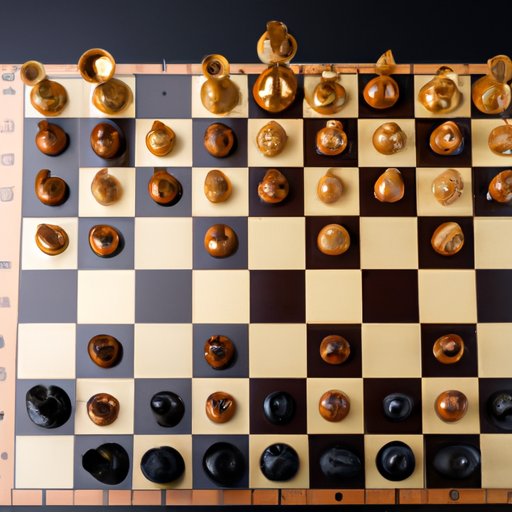
I. Introduction
Chess is a strategy game that has been played for centuries and is still popular today. It is a game of intelligence, strategy, and patience that requires players to think several moves ahead. This article is a beginner’s guide to playing chess. Its aim is to provide step-by-step instructions and examples to make it easy for beginners to learn and enjoy the game.
II. Getting Started: How to Set Up a Game and Learn the Basic Rules
The chess board consists of 64 squares, alternating in colors between black and white. Each player has 16 pieces: one king, one queen, two rooks, two knights, two bishops, and eight pawns. The board is set up so that each player has a white square in the bottom right-hand corner.
The basic rules of movement and capture are as follows:
- The pawns move forward one square at a time and capture diagonally forward one square.
- The rooks move horizontally or vertically any number of squares.
- The knights move in an L-shaped pattern, two squares forward and one square sideways.
- The bishops move diagonally any number of squares.
- The queen moves horizontally, vertically, or diagonally any number of squares.
- The king moves one square in any direction.
- The goal of the game is to checkmate the opponent’s king, that is, to put it into a position where it is in check and cannot escape capture.
Examples of each piece’s movement and capture can be found online or in chess books to make it easy for beginners to understand.
III. Winning Strategies and Tactics in Chess
Chess is a game of strategy and tactics. Common strategies include controlling the center of the board, developing pieces quickly, and having a good opening repertoire. Recognizing patterns such as pinning, discovered attacks, and forks can also help players win games.
When developing an opening strategy, it’s important to consider the objective of the opening, such as controlling the center or preparing for castling. It’s also important to understand the strengths and weaknesses of each piece and how they can best be used together.
Examples of winning strategies and tactics can be found online or in chess books to make it easy for beginners to understand.
IV. Common Mistakes Made by Beginners and How to Avoid Them
Beginners often make common mistakes in playing chess. Some of these mistakes include failing to control the center of the board, moving pawns too much, neglecting to develop pieces, and not recognizing patterns that can lead to mistakes.
One common mistake is making false assumptions about certain moves, such as moving a piece too far forward or neglecting to protect a piece. It’s important to take time to analyze each move and understand its potential risks and benefits.
To avoid making common mistakes, beginners should take time to understand the rules and strategies of the game, practice with other players, and learn from their mistakes.
V. Reviewing Games to Improve Skills
Reviewing games is an essential part of improving chess skills. It helps players learn from their mistakes and identify areas where they need to improve. When reviewing games, it’s important to analyze the opening, evaluate the middle game, and inspect the endgame.
Beginners should look for mistakes they made and analyze why they occurred. They should also look for patterns and mistakes their opponents made, and try to learn from these as well.
Lessons learned from reviewing games can be incorporated into future games to improve gameplay.
VI. Finding Players to Play Chess With
There are many ways to find other players to play chess with. Beginners can start by asking friends and family members if they are interested in playing. They can also join a local chess club or community center to find other players of all skill levels.
Online platforms such as Chess.com and Lichess.org provide opportunities to play chess with players from all over the world. Beginners can also join online communities such as Reddit’s r/chess to discuss strategies and find other players.
VII. Benefits of Playing Chess
Playing chess has cognitive and analytical benefits such as improving memory, increasing creativity, and developing problem-solving skills. It can also improve concentration and focus, as well as stimulate brain activity.
Studies have shown that playing chess can help improve academic performance and even reduce the risk of Alzheimer’s disease.
VIII. Instructional Videos and Diagrams
Instructional videos and diagrams can be helpful for beginners who want to improve their skills. There are many online resources that provide step-by-step instructions on specific moves and strategies.
Chess.com and Lichess.org provide instructional videos for players of all skill levels. Additionally, YouTube provides many instructional videos from chess professionals such as GM Yasser Seirawan.
Step-by-step instructions and diagrams can also be found in chess books and online resources.
IX. Conclusion
Chess is a game of intelligence, strategy, and patience. Beginners can learn and enjoy the game by following basic rules, learning winning strategies, avoiding common mistakes, reviewing games, and finding players to practice with. The game provides cognitive and analytical benefits that also transfer to other areas of life.





